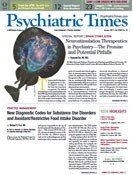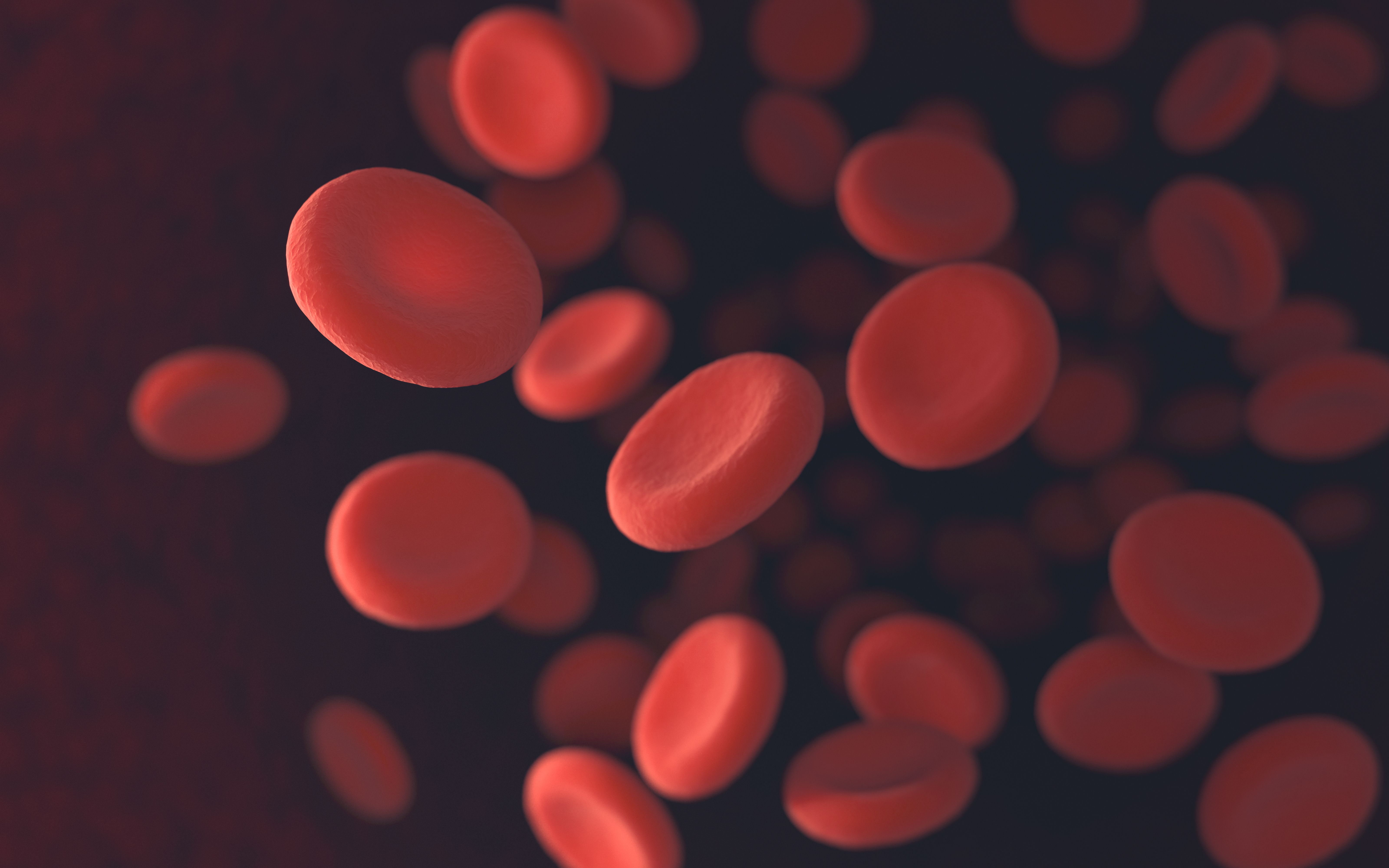Publication
Article
Psychiatric Times
The Hypothalamic-Pituitary-Gonadal Axis and Women’s Mental Health: PCOS, Premenstrual Dysphoric Disorder, and Perimenopause
Author(s):
The authors review basic neuroendocrine function and the evidence base of hormonal contribution to psychiatric symptoms in PCOS, PMDD, and perimenopause. They also offer strategies for psychiatrists for both clinical assessment and management of women with neuroendocrine dysfunction.
Figure.
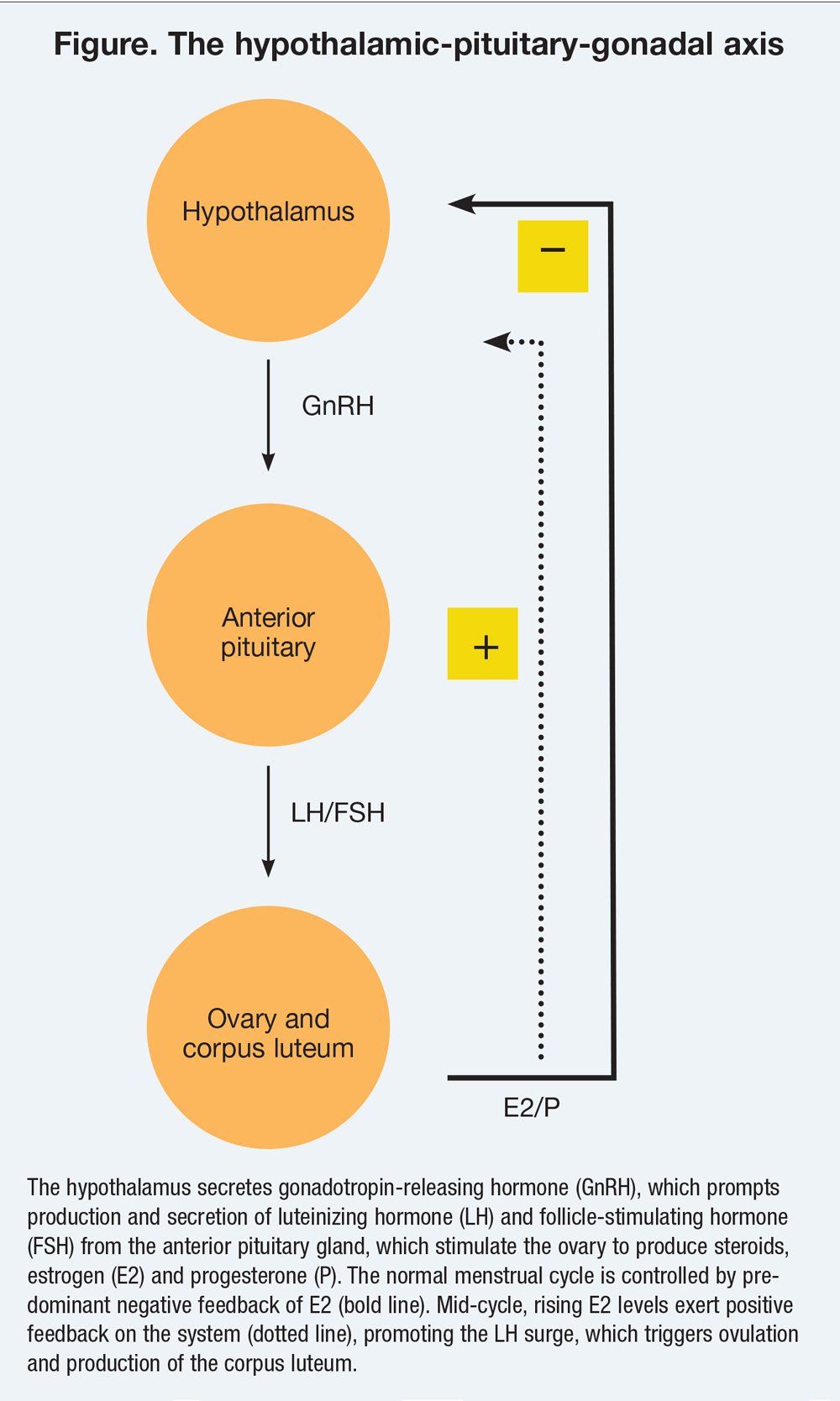
Table 1 – Major hormones of the HPG axis
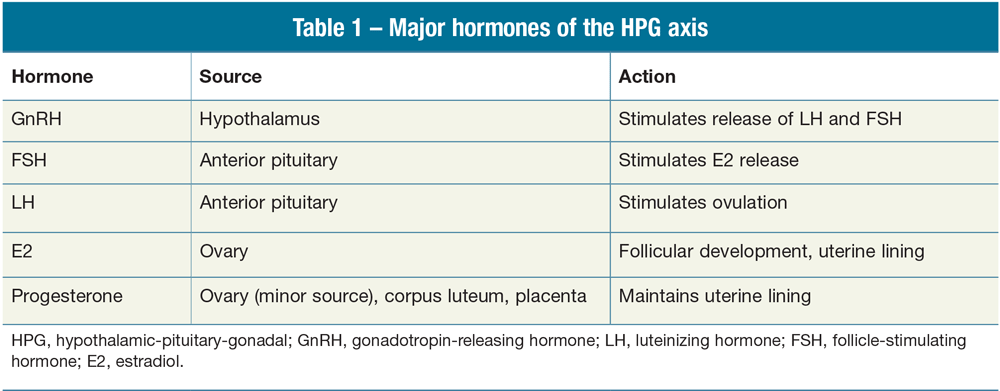
Table 2 – Summary of management of PCOS, premenstrual dysphoric disorder, and perimenopause
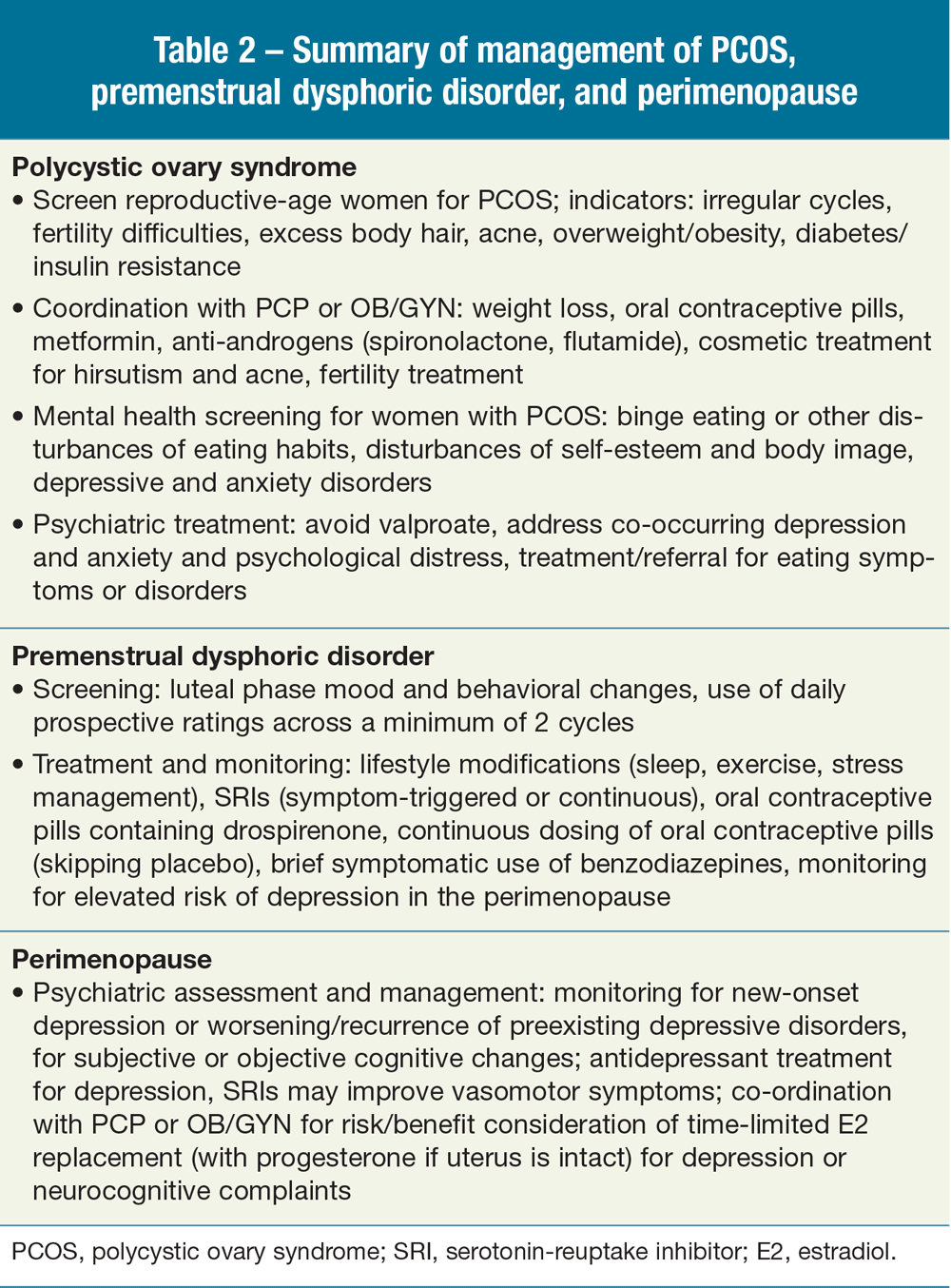
Many psychiatric disorders are more prevalent in women during their reproductive years and at stages of life associated with changes in the hormonal milieu. The neuroendocrine system, including central brain circuits, gonadal functions, and other target organs, has been implicated in the development of psychiatric conditions, such as mood, anxiety, and cognitive disorders. The hypothalamic-pituitary-gonadal (HPG) axis coordinates a tightly regulated feedback loop that consists of gonadotropin-releasing hormone (GnRH) produced by the hypothalamus; follicle-stimulating hormone (FSH) and luteinizing hormone (LH) from the anterior pituitary; and the sex steroids estrogen, progesterone, and androgens, produced primarily by the ovary, corpus luteum, and adrenals (Table 1; Figure). Cyclic and episodic alterations in the HPG axis across the menstrual cycle and during important reproductive health events, such as pregnancy and menopause, are hypothesized to alter the sensitivity of neurotransmitter systems and the function of neural circuits in ways that increase vulnerability to psychiatric symptoms for some women.
This article reviews basic neuroendocrine function and discusses the evidence base of hormonal contribution to psychiatric symptoms in polycystic ovary syndrome (PCOS), premenstrual dysphoric disorder (PMDD), and perimenopause. Strategies for psychiatrists for both clinical assessment and management of female patients with neuroendocrine dysfunction are provided, and the role of hormonal therapies in exacerbating or alleviating neuropsychiatric symptoms in these conditions is explored (Table 2).
POLYCYSTIC OVARY SYNDROME
PCOS is one of the most common endocrine disorders in women of childbearing age and is a leading cause of menstrual irregularity and anovulatory infertility. In the US prevalence is 6% to 15%, depending on the criteria used for diagnosis.1 The core features of PCOS include hyperandrogenemia, menstrual irregularities/oligovulation or anovulation, and polycystic ovaries. Women with PCOS also commonly have metabolic disturbances such as reduced insulin sensitivity and obesity.
Presentation and clinical features
The characteristic problems of PCOS can be separated into reproductive/menstrual abnormalities, hyperandrogenemia, and metabolic dysfunction. Hyperandrogenemia is identified clinically by hirsutism, acne, and male-pattern alopecia; or biochemically, with elevated levels of testosterone, dehydroepiandrosterone sulfate, or androstenedione. Irregular or absent ovulation leads to the menstrual abnormalities typical of PCOS, including oligomenorrhea/amenorrhea and dysfunctional uterine bleeding (breakthrough bleeding and menorrhagia).
Infertility is common, and ovulation induction is often necessary for conception. There are increased rates of spontaneous abortion, premature delivery, pregnancy-induced hypertension, and gestational diabetes -independent of weight. Women with PCOS have an elevated risk of endometrial cancer because of less frequent exposure to ovulatory surges of progesterone and menstrual bleeding. They are also more likely to be obese, with rates varying according to environmental and cultural factors.1
Insulin resistance affects more than three-quarters of women with PCOS, even those who are lean. Rates of type 2 diabetes and gestational diabetes are higher in those with PCOS, as is metabolic syndrome.2 The menstrual irregularities of PCOS may improve as women age and androgen levels decrease. Women with a history of PCOS may have persistent hyperandrogenemia and metabolic disturbances after menopause, and they may experience less severe vasomotor symptoms during the menopausal transition.
Pathogenesis and etiology
PCOS appears to be a multifactorial disorder, with genetic and environmental contributions.1,2 Excessive androgen production in the ovary leads to hyperandrogenemia, as well as the maturation and premature arrest of maturing follicles, which creates the characteristic polycystic ovary morphology. Insulin resistance and hyperinsulinemia further aggravate ovarian androgen production by stimulating the ovarian theca cells to produce androgens in response to LH and disrupting central control of gonadotropins. Circulating androgens may negatively and positively modulate the gamma-aminobutyric acid (GABA) and N-methyl d-aspartate (NMDA) systems, respectively.3
Mental health implications
Disturbances of mental health are prevalent in PCOS.2,4 Hirsutism and obesity may have a negative impact on body image and feelings of attractiveness; menstrual dysfunction and anovulation may raise concerns about female identity; and challenges with fertility may cause emotional suffering and relationship disruption. Higher rates of depression and anxiety appear to be associated with features of PCOS, including obesity and signs of hyperandrogenemia. PCOS has also been associated with lower quality of life and higher distress scores. Disordered eating, particularly binge eating, appears to be more common in women with PCOS than in controls.
Associations have been found between bipolar disorder and PCOS, and this appears to be most closely linked to the use of valproate. There is limited convincing evidence that women with bipolar disorder are more likely to have PCOS than women without bipolar disorder, when they are not treated with valproate.5 A study that evaluated menstrual abnormalities and hyperandrogenemia in women with bipolar disorder did not find either measure to be significantly higher in patients with bipolar disorder than in a control group.6 On the other hand, bipolar disorder may be more common among women with PCOS than in the general population. A screening study of women with PCOS found higher rates of bipolar disorder than in women without PCOS, independent of valproate treatment, although the findings are limited by sample size, lack of a control group, and non-standardized diagnostic criteria for PCOS.7
The moderating effect of valproate on the risk of PCOS is clearer, although the same limitations of inconsistent PCOS diagnostic criteria and methodological differences among studies exist. Valproate appears to increase the risk of PCOS in women with epilepsy, a population with high baseline rates of PCOS and reproductive abnormalities, thought to be related to the effect of epileptic activity on hypothalamic function.
The association between valproate on the incidence and prevalence of PCOS in women with bipolar disorder has been studied. Rates of PCOS are higher in women who take valproate than in those who take other antimanic agents.5 Valproate may contribute to PCOS via the alteration of androgen production and insulin metabolism and functioning, and is less likely to be a direct effect of weight gain.
While there remains uncertainty about the specific relationship between valproate and PCOS, and its clinical significance, prescribers should be mindful of this potential risk when making treatment decisions. In the context of other negative or undesirable effects such as weight gain, hair loss, and teratogenicity in the case of pregnancy, alternate treatments should be strongly considered before recommending valproate in women of reproductive age.
Treatment
Treatment must address the common features of PCOS: menstrual dysfunction, infertility, acne and hirsutism, metabolic disorder, and mental health disturbances. The reproductive, dermatologic, and metabolic aspects of the syndrome should be managed by a primary care provider or relevant specialist. Weight loss is recommended for overweight or obese women with PCOS; it may be associated with direct improvement of reproductive functioning, metabolic health, and cosmetic appearance. For women who are not actively pursuing pregnancy, hormonal contraception is a first-line treatment. Estrogen in oral contraceptive pills suppresses hyperandrogenemia, and cyclic progestin exposure prevents endometrial hyperproliferation.
Metformin has demonstrated benefit on menstrual functioning as well as weight and insulin sensitivity. Antiandrogens, such as spironolactone and flutamide, may improve cutaneous features of hyperandrogenemia as well as menstrual function.8 Cosmetic treatments can be used to ameliorate acne and hirsutism. In refractory cases, pituitary suppression of gonadal hormones, or surgery, may be recommended by the medical provider. Ovulation induction and other fertility treatments are commonly needed for those who seek pregnancy. Psychiatric disorders, including anxiety, depression and eating disorders, should be actively screened for and addressed.
The psychiatrist plays a pivotal role in the management of patients with PCOS and should be knowledgeable about the condition, because of its prevalence in women of reproductive age. In addition to identification and management of the co-occurring mental health conditions in women with established PCOS, the mental health provider should assess for the features of PCOS such as menstrual abnormalities and dermatologic features in women who present with depression, anxiety, bipolar disorder, and eating disorders. Facilitating appropriate referral to a primary care provider for further evaluation, treatment, and specialist involvement allows for more women with PCOS to receive a diagnosis as well as needed attention -with significant implications for reproductive, metabolic, and mental health.
PREMENSTRUAL DYSPHORIC DISORDER
Psychological and physical symptoms that present in the second half of the menstrual cycle comprise premenstrual syndrome (PMS) and the more severe PMDD. Common symptoms include bloating, mood swings, lethargy, irritability, breast tenderness, anxiety or tension, and rejection sensitivity.
The American College of Obstetricians and Gynecologists defines PMS as the presence in the 5 days prior to menses of at least one physical or emotional symptom causing impairment in social or occupational functioning that must recur for a minimum of 3 consecutive cycles.9 A diagnosis of PMDD, as described in DSM-5, requires at least 5 symptoms from a list of psychological, physical, and behavioral symptoms, confirmed by the use of prospective daily ratings (eg, The Daily Record of Severity of Problems) over a minimum of 2 cycles. The symptoms, which should occur in the week leading up to menses and be largely absent following menses, must be present in the majority of cycles, cause impairment, and be distinct from an exacerbation of another mental disorder or a medical condition. Women who do not menstruate because of hysterectomy or an intrauterine device may still be ovulating, and they can have PMDD if their symptoms follow a pattern consistent with a menstrual cycle.
Epidemiology and risk factors
Although up to 85% of menstruating women may experience at least one menstrual-related symptom, conservative estimates indicate a prevalence of 5% for clinically significant premenstrual disorders.10 PMDD affects women across different cultures and ethnicities. Factors associated with a diagnosis of PMS and PMDD include increased weight, a history of sexual abuse or trauma, and additional psychiatric disorders including other depressive disorders, anxiety disorders, and substance use disorders. Women with a history of PMS/PMDD may be at elevated risk for postpartum depression and for depression during perimenopause. Moreover, there appears to be a genetic contribution to susceptibility to PMDD.10
Pathogenesis and etiology
PMDD occurs exclusively in ovulating women and is thought to require fluctuating gonadal hormones. No studies have demonstrated significant differences in any specific hormone in women with PMDD; therefore, leading theories posit that the clinical expression of PMDD is related to increased sensitivity to changes in gonadal hormones, and their modulation of neurotransmitter systems, predominantly serotonin and GABA.11
Differences in serotonin activity, improvement of symptoms in response to serotonin agonists and serotonin-reuptake inhibitors (SRIs), and worsening of symptoms in response to serotonin antagonists and depletion of the serotonin precursor tryptophan have been seen in women with premenstrual mood changes.10 Differences in sensitivity to and regulation of the progesterone metabolite allopregnanolone -a stress-responsive GABA receptor agonist -have also been implicated in the symptoms of PMDD.3
Treatment
Despite a lack of strong evidence, first-line management of PMDD is with lifestyle modifications (ie, sleep hygiene, exercise, stress management).9 Psychotherapy such as CBT may help women avoid stressors and better tolerate distress during symptomatic days. For moderate to severe symptoms, SRIs (including SSRIs and SNRIs) are recommended, with a response rate of up to 70%. Doses can be effective at the low end of therapeutic doses for depression, but moderate doses are often required. SRIs can be dosed during the luteal phase or at the start of symptoms, or they can be dosed continually throughout the month. Factors such as cycle and symptom regularity, adverse-effect profile, and personal preference may guide the dosing schedule.
In contrast to depression, the benefits of SRIs for PMDD are observed soon after the first dose, and patients on luteal-phase dosing do not appear to experience withdrawal symptoms when dosing stops each month.
If symptoms persist following an adequate trial of SRIs, hormonal therapy with an oral combination of ethinyl estradiol and the progestin drospirenone is indicated for ovulation suppression. Drospirenone may be particularly effective for PMDD because of its antiandrogenic effects; however, the risk of venous thromboembolism appears to be higher than that of other progestins.
There is evidence that continual dosing of oral contraceptive pills, skipping placebo pill days for several consecutive months, provides symptom relief, likely because of better suppression of ovulation. Antiandrogenic agents, such as spironolactone, finasteride, and flutamide, may be useful for women who cannot take SRIs or hormonal therapies. Brief use of alprazolam during the symptomatic period may also benefit some women. The GnRH antagonist leuprolide, with add-back estrogen and progesterone, or surgical removal of the ovaries may be required for refractory cases.
THE PERIMENOPAUSE
The menopausal transition occurs in the setting of reduced numbers of ovarian follicles, lower levels of follicle-derived inhibin B, and increased production of FSH from the anterior pituitary gland. Menstrual cycles become longer and more variable in duration, and non-ovulatory cycles are more prevalent. Progesterone levels drop, and levels of physiologic estrogen (estradiol [E2]) become more variable than with premenopausal cycles. Subsequently, menstrual cycles cease, and ovarian E2 and progesterone production fall to minimal levels, characterizing the postmenopausal state. The perimenopausal period can be associated with vasomotor symptoms, alterations in sexual functioning, and mood and cognitive changes.
Depression and perimenopause
Depressive disorders are twice as common in women, with rates diverging at puberty and aligning again in the postmenopausal period. Some women appear to be more prone to depressive symptoms and disorders at particular points of the reproductive cycle, such as during the luteal phase of the menstrual cycle, the postpartum period, and the perimenopause. In addition to such epidemiological data, basic and translational studies have elucidated connections between gonadal steroids and neurotransmitters, neurotrophic factors and inflammation, the hypothalamic-pituitary-adrenal (HPA) axis, and systems of the brain related to emotional processing.12,13 Together, the available research suggests that changes in ovarian hormones play a key role in the development of depressive syndromes in at least a subset of women.
While most women do not experience significant depression during the perimenopause, there may be a 2-fold risk of depression during this period. Women with a history of depression may be at greater risk for recurrence during the menopausal transition. The degree of fluctuations in levels of E2 and FSH and the severity of self-reported vasomotor symptoms have been associated with a higher risk of perimenopausal-onset depression.14 Such findings suggest that mood symptoms may develop in response to highly variable hormone levels, and depend on the ability of the brain to adapt to those fluctuating levels. The finding that perimenopausal women with depression benefit from estrogen therapy, while exogenous estrogen does not appear to improve depression later in the postmenopausal period, further supports the premise that it is the instability of gonadal steroids and trophic factors that drives the depressive symptoms, rather than a primary hormone deficiency.15
Ovarian hormones may contribute to perimenopausal-onset depression in several ways. E2 raises levels of available serotonin and norepinephrine through reduced degradation and increased synthesis, modulates the serotonin reuptake transporter and receptors, and may affect levels of neurotrophins, such as brain-derived neurotrophic factor. E2 appears to be implicated in reward circuitry.16 E2 and progesterone are active in areas of the brain associated with mood and emotional processing, such as the prefrontal cortex, hippocampus, and brainstem. Perimenopausal depression may be related to dysfunction of the GABA system and the HPA axis in response to stress in the presence of changing ovarian hormone and neurosteroid levels.
Options for pharmacologic management of perimenopausal depression include antidepressants and hormone therapy. Despite some inconsistencies in the literature, there appears to be a benefit of E2 replacement in women within the perimenopausal period, whereas there was no improvement seen in women who have transitioned into menopause, which suggests a “critical window” for E2 replacement in depressive disorders.
The efficacy of E2 may be related to stabilization of circulating estrogen and FSH levels. Transdermal E2 may be more effective than oral formulations, although the literature is discrepant. Exogenous progestins, indicated if the patient has an intact uterus, may reduce the antidepressant benefit of E2 therapy. Menopausal hormone therapy carries an increased risk of adverse cardiovascular outcomes and cancer -among other risks -although evidence for short-term use (ie, 5 years) during the perimenopausal period and early menopause may be considered after discussion of individual risks and benefits with the patient’s medical provider.
SRIs have demonstrated efficacy in women with perimenopausal depression and may have the added benefit of improving vasomotor symptoms. Head-to-head studies of hormone therapy versus antidepressants for perimenopausal depression are lacking.
Cognition and perimenopause
Uncertainties exist about the effect of the menopausal transition on neurocognitive functioning, although there is an emerging literature on the effect of ovarian hormones and neurosteroids on the aging brain. While women may report changes such as impaired memory and concentration, there is a dearth of studies that demonstrate specific changes in neurocognitive profiles. Estrogen depletion, either in the natural menopausal period or due to oophorectomy before menopause, appears to be associated with cognitive decline. This finding is supported by compelling human and animal studies and has led to interest in estrogen therapy after menopause to prevent or ameliorate age-related cognitive decline.
Estrogen’s potential benefits on cognition may be mediated through effects on the acetylcholine system, prefrontal cortex functioning, and dendritic spine density. Early studies of postmenopausal exogenous estrogen use suggested reduced risk of cognitive disorders, which was later questioned by results of the Women’s Health Initiative that suggested no cognitive benefit or an increased risk of cognitive impairment in some groups.17
Current theories suggest that -as with depression -there may be a critical period for estrogen treatment during perimenopause or early postmenopause (ages 50 to 60) that may lead to improved cognition and/or prevention of age-related cognitive decline, perhaps with sustained benefit well beyond the cessation of hormone therapy. By comparison, initiation of estrogen treatment in the late postmenopausal stage (ages 65 to 79) may be associated with an increased risk of neurocognitive disorders.
While there is no approved indication for perimenopausal use of hormone treatment for cognition, women who undergo early surgical menopause or experience premature menopause should be considered for hormonal treatment until the average age of natural menopause. There are insufficient data at this time to make recommendations for hormone therapy in women who experience natural menopause at the expected age. If a woman chooses to begin treatment because of menopausal symptoms such as vasomotor symptoms, vaginal dryness, or mood instability, it is suggested that short-term use may have added benefit for her neuorocognitive health.
CONCLUSION
Women experience higher rates of several common psychiatric disorders, and they appear to be at elevated risk during their reproductive years and at specific reproductive transitional points. Pituitary and ovarian hormones have been implicated in these sex- and phase-specific differences. The mental health provider should be knowledgeable about prevalent psychiatric presentations related to reproductive functioning, including those reviewed in this article. Gaining appreciation for the effect of the HPG axis on neurobiology and mental health, as well as learning to recognize, assess, and manage or refer to the appropriate specialist, will enhance the mental health clinician’s capacity to serve the needs of women across the reproductive life cycle -as provider, liaison, and advocate.
Acknowledgment -The authors acknowledge the Academy of Psychosomatic Medicine (APM) for helping to bring this article to fruition. The APM is the professional home for psychiatrists providing collaborative care bridging physical and mental health. Over 1200 members offer psychiatric treatment in general medical hospitals, primary care, and outpatient medical settings for patients with comorbid medical conditions.
Disclosures:
Dr. Gordon-Elliott is Assistant Professor of Clinical Psychiatry, New York-Presbyterian/Weill Cornell Medicine; Dr. Ernst is Associate Professor of Psychiatry, Icahn School of Medicine at Mount Sinai Hospital, New York; Dr. Fersh is Assistant Professor of Psychiatry, Long Island Jewish Medical Center/Hofstra Northwell School of Medicine, Hempstead, NY; Dr. Albertini is Assistant Professor of Psychiatry, Icahn School of Medicine at Mount Sinai Hospital; Dr. Lusskin is Clinical Professor of Psychiatry, Obstetrics, Gynecology, and Reproductive Science, Icahn School of Medicine at Mount Sinai Hospital; Dr. Altemus is Associate Professor of Psychiatry, Yale School of Medicine, New Haven, CT.
References:
1. El Hayek S, Bitar L, Hamdar LH, et al. Poly cystic ovarian syndrome: an updated overview. Front Physiol. 2016;7:124.
2. Teede H, Deeks A, Moran L. Polycystic ovary syndrome: a complex condition with psychological, reproductive and metabolic manifestations that impacts on health across the lifespan. BMC Med. 2010;8:41.
3. Crowley SK, Girdler SS. Neurosteroid, GABAergic and hypothalamic pituitary adrenal (HPA) axis regulation: what is the current state of knowledge in humans? Psychopharmacol. 2014;231:3619-3634.
4. Cesta CE, Mansson M, Palm C, et al. Polycystic ovary syndrome and psychiatric disorders: co-morbidity and heritability in a nationwide Swedish cohort. Psychoneuroendocrinol. 2016;73:196-203.
5. Bilo L, Meo R. Polycystic ovary syndrome in women using valproate: a review. Gynecol Endocrinol. 2008;24:562-570.
6. Reynolds-May MF, Kenna HA, Marsh W, et al. Evaluation of reproductive function in women treated for bipolar disorder compared to healthy controls. Bipolar Disord. 2014;16:37-47.
7. Klipstein KG, Goldberg JF. Screening for bipolar disorder in women with polycystic ovary syndrome: a pilot study. J Affect Disord. 2006;91:205-209.
8. Paradisi R, Fabbri R, Battaglia C, Venturoli S. Ovulatory effects of flutamide in the polycystic ovary syndrome. Gynecol Endocrinol. 2013;29:391-395.
9. Lanza di Scalea T, Pearlstein T. Premenstrual dysphoric disorder. Psychiatr Clin North Am. 2017;40:201-216.
10. Yonkers KA, Simoni MK. Premenstrual disorders: an expert review. Am J Obstet Gynecol. May 2017; Epub ahead of print.
11. Backstrom T, Bixo M, Stromberg J. GABAA receptor-modulating steroids in relation to women’s behavioral health. Curr Psychiatry Rep. 2015;17:92-98.
12. Borrow AP, Cameron NM. Estrogenic mediation of serotonergic and neurotrophic systems: implications for female mood disorders. Prog Neuropsychopharmacol Biol Psychiatry. 2014;54:13-25.
13. Gordon JL, Girdler SS, Meltzer-Brody SE, et al. Ovarian hormone fluctuation, neurosteroids, and HPA axis dysregulation in perimenopausal depression: a novel heuristic model. Am J Psychiatry. 2015;172:227-236.
14. Joffe H, Hall JE, Soares CN, Hennen J, et al. Vasomotor symptoms are associated with depression in perimenopausal women seeking primary care. Menopause. 2002;9:392-398.
15. Soares CN. Mood disorders in midlife women: understanding the critical window and its clinical implications. Menopause. 2014;21:198-206.
16. Nestler EJ, Carleazon WA Jr. The mesolimbic dopamine reward circuit in depression. Biol Psychiatry. 2006;59:1151-1159.
17. Shumaker SA, Legault C, Rapp SR, et al, for the WHIMS Investigators. Estrogen plus progestin and the incidence of dementia and mild cognitive impairment in postmenopausal women: the Women’s Health Initiative Memory Study: a randomized controlled trial. JAMA. 2003;289:2651-2662.
